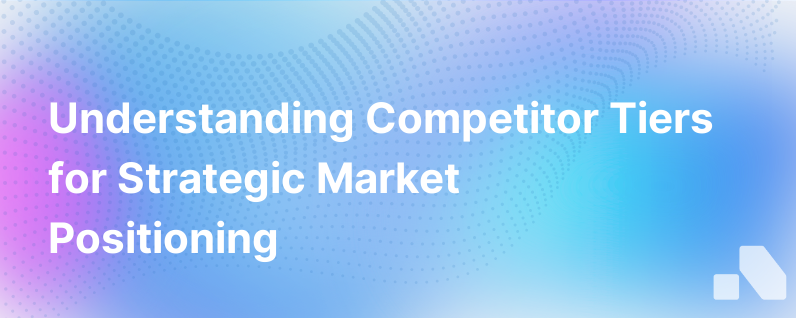Competitor Tiers
Published on December 30, 2023 by Sawyer Middeleer
The competitive landscape is an ever-evolving battlefield that organizations must continuously navigate. Knowing your competitor tiers plays a critical role in your marketing, product development, sales, and most importantly, your survival in the market. Every business interacts with three tiers of competitors: direct, indirect, and aspirational.
In today's article, we'll discuss these three competitor tiers in-depth, explore why they matter, and provide insights to help you outmaneuver them.
Direct Competitors
Direct competitors fill the first tier. They're the most visible and, often, the most formidable threat. Why? Simply put, they target the same audience, offer similar products or services, and operate within the same geographic bounds.
Identifying and monitoring direct competitors are essential because buyers often perform side-by-side comparisons when considering various services or products.
Many factors contribute to this head-to-head competition: price, product features, innovation, customer service, and brand reputation all play a role. To hold your ground, you must amplify your differentiation, continuously improve your offering, and strategically adjust your pricing strategy.
Your competitive analysis for this tier should be exhaustively detailed and updated regularly.
Indirect Competitors
In the second tier, we find indirect competitors. These are businesses that offer different products or services but cater to the same customer needs or solve the same problems. They’re easily overlooked but can be considered a substantial business threat.
For example, in the transportation market, Uber, bike rentals, public transit, and even car manufacturers could all be considered indirect competitors.
Understanding your indirect competition helps in many ways. It can illuminate gaps in the market, provide a more holistic view of the customer’s decision-making process, and open opportunities for partnerships or alliances.
Your competitive analysis for this tier should focus on customer decision-making criteria and partnership opportunities.
Aspirational Competitors
Aspirational competitors sit at the third tier. These are businesses you look up to and aspire to rival. They're not currently in your competitive space but represent where you want your company to be.
This doesn't mean you need to imitate them. Instead, it's about understanding what they do well and how they manage challenges. You can learn from their success stories and failures without having to take the same risks or invest the same resources.
Your competitive analysis for this tier should focus on best-in-class practices, vision alignment, and long-term strategic planning.
Why Understanding Competitor Tiers Matter
Understanding your competitor tiers gives you a comprehensive view of your competitive landscape. It enables you to establish a solid position in your market, make informed strategic decisions, and navigate threats and opportunities.
Equipped with comprehensive competitive analysis, you can create strategies that matter in the following areas:
Go-to-market strategy: Understanding your competitors can sharpen your market distinction, strengthen your value proposition, and improve your brand strategy.
Sales Strategy: Sales teams armed with competitor insights can handle objections, articulate your competitive advantage, and win more deals.
Product Strategy: You can identify gaps in the market, map your product development roadmap, and innovate to stay ahead.
Pricing Strategy: You can optimize your pricing strategy to achieve competitive advantage without sacrificing profitability.
Customer Success Strategy: By understanding the customer’s alternatives, you can provide more value, reduce churn, and boost customer satisfaction.
How Aomni Can Help
Traditionally, businesses have relied on manual research and spider-web infographics to track competitors.
Enter Aomni, an AI platform to help businesses act more intelligently on competitors. With capabilities like real-time competitive research, actionable sales content, and personalized insights, Aomni simplifies the process.
Since Aomni provides all the information required to understand your competitive landscape, it ultimately reduces the time spent collating and analyzing data. With comprehensive, real-time insights into direct, indirect, and aspirational competitors, Aomni helps businesses stay nimble, respond effectively to competitor moves, and craft successful strategies.
Conclusion
Knowing your competitor tiers is crucial to ensuring your company's growth and sustainability. Understanding both the competitive landscape and your place within it can be a game-changer. Aomni steps in to simplify this process, delivering comprehensive insights that empower you to act intelligently and strategically, guiding your business to success.